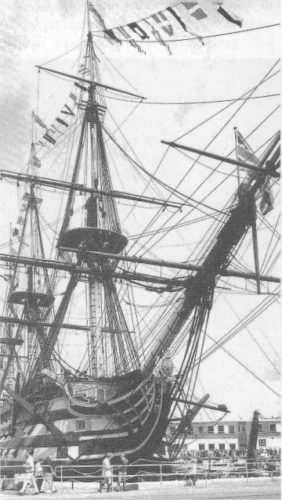- Author
- Jarrett, Hugh
- Subjects
- 19th century wars, Ship histories and stories
- Tags
-
- RAN Ships
- None noted.
- Publication
- September 2002 edition of the Naval Historical Review (all rights reserved)
It is nearly two hundred years since the Battle of Trafalgar and on the anniversary of that great battle, 21st October, in clubs and naval messes across the world, the toast will be “…to the Immortal Memory”. Few however will pause to consider anything but the great admiral and his victories which were achieved in magnificent sailing ships-of-the-line, often referred to as “liners”. This monograph aims to review the history of the greatest liner of them all – HMS Victory.
The keel of victory was laid down in the old Single Dock at Chatham on 23rd July 1795 during the Seven Years War. She is now well into her third century of life.

Initially, the name Victory was unpopular with sailors and the public because the previous Victory was lost with all hands – over 1,000 men – in 1744. In spite of this, the Admiralty had her christened Victory. As if to confirm her critics, when she was floated out of the building dock on 7th May 1765, she was seen to have a list to starboard necessitating 38 tons of extra ballast being loaded on her port side to level the imbalance. By modern displacement measurement she was 3,500 tons. As it was now peace once more, she was laid up in Reserve in Ordinary for eleven years until the American Colonial Revolt when she hoisted the flag of Admiral the Hon. Augustus Keppel as flagship of the Grand Fleet in March 1778.
The Battle of the Ushant
In June, Admiral Keppel sailed from Portsmouth with twenty ships and fell in with two French frigates upon which he opened fire bringing them to, thereby opening the war. From papers seized from the frigates he found that thirty two French ships were in Brest, causing him to return at once to Portsmouth for reinforcements. This enabled him to sail again with thirty sail-of-the-line and fall in with the French fleet of equal strength under D’Orvilliers to the west of the Ushant. Keppel was to windward of the French in a westerly wind and on 27th July fought the first fleet action of the war. Victory had a sharp encounter with the French flagship, the 110 gun Bretagne, which was badly damaged but had severely smashed Victory’s masts and spars. The result was indecisive with no ships being taken or sunk, both fleets returning to their home ports.
The action caused a great outcry in England at its lack of result and was followed by naval and political controversy. Admiral Keppel and his third in command belonged to different political parties, Whigs and Tories, and made charges against each other. In the ensuing court-martial all England was divided, chiefly on party lines, but public and naval sentiment mainly favoured the commander-in-chief. Admiral Keppel and his second-in-command Vice Admiral Palliser were acquitted. A not altogether auspicious beginning for Victory’s career.
In 1799 she became the flagship of Admiral Hardy, who with thirty-seven sail-of-the-line and no reserves available, prevented the invasion of England by standing off before a combined Franco-Spanish fleet of sixty-six ships which finally turned tail and returned to port. The King and the public reviled Hardy for not engaging the foe, but the Admiralty approved the strategy. On 8th May 1779 Admiral Hardy died and was succeeded by Admiral Geary, who cruised off Brest with a fleet of twenty-nine ships. He intercepted a French merchant convoy of twenty ships and captured twelve. On return to port after eleven weeks at sea all the provisions in the fleet were condemned. There were over 2,000 sick men in the fleet, including Admiral Geary, who had to be retired.
Private Ship
In 1781, Victory was relieved as fleet flagship by Britannia and became a ‘private ship’, i.e. a Captain’s command without an admiral on board. During the Great Siege of Gibraltar, on 20th March, Vice-Admiral Parker hoisted his flag in Victory when the Grand Fleet covered several convoys and relieved Gibraltar. After the successful completion of these tasks, Admiral Parker hauled down his flag and Victory reverted to being a Private Ship. In September 1781, Victory became the flagship of Rear-Admiral Richard Kempenfelt. When he had served in Victory previously as Captain of the Fleet he had perfected a system of signals which he was about to put to the test in very salutary manner.
The Kempenfelt System
Admiral Kempenfelt in Victory led his squadron of twelve ships-of-the-line to intercept a French convoy of twenty supply ships escorted by a squadron of nineteen ships-of-the-line plus two 64 gun ships armed ‘en flute’. (‘En flute’ – a warship with her armament almost entirely removed in order to be used as a storeship or transport). The French force was commanded by the master tactician Admiral Comte Luc-Urbain de Guichen. Kempenfelt had drilled his squadron in his new system of signals which was now to be put to the test.




